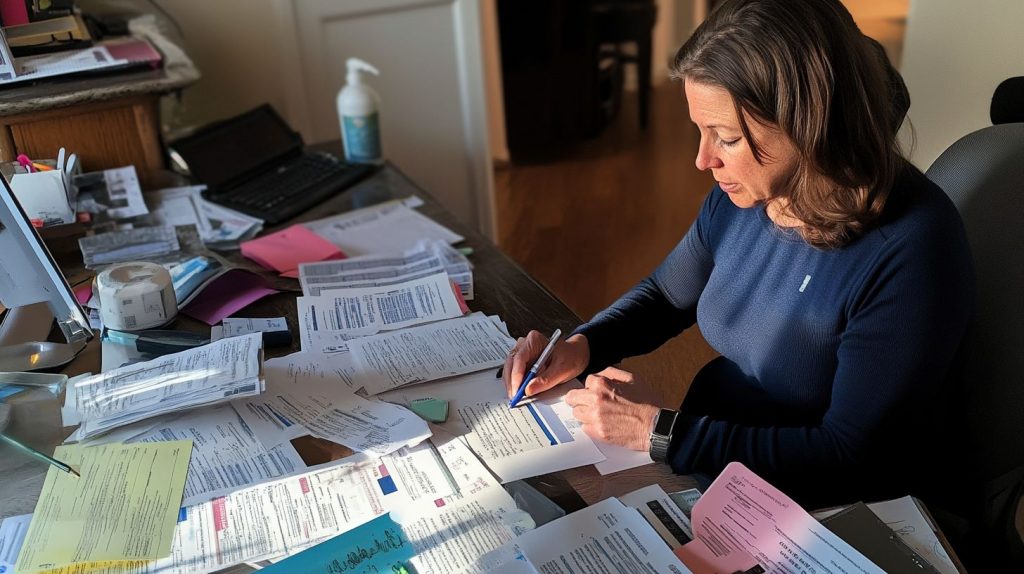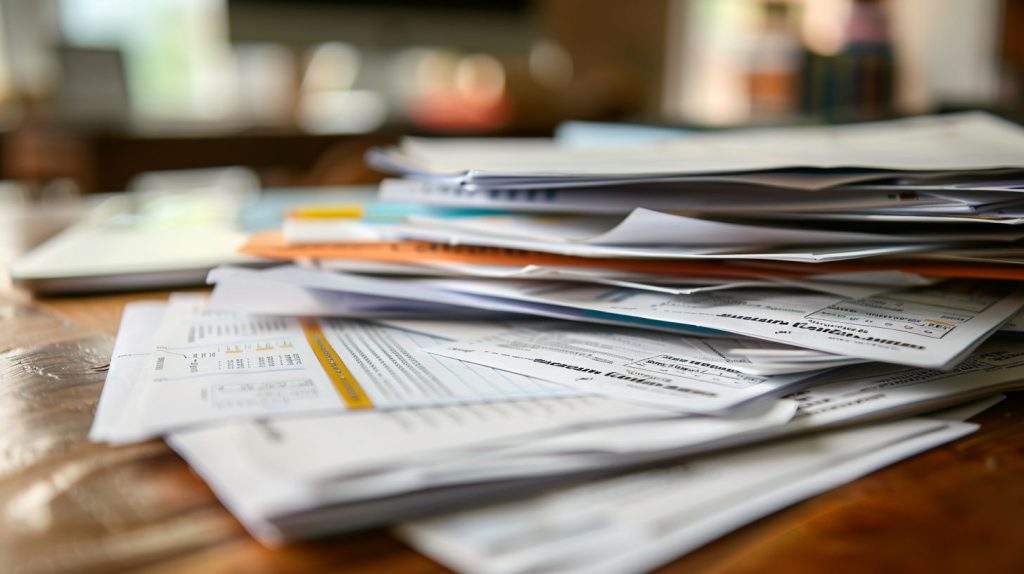Canadian Debt Relief Program

Struggling with debt can feel like climbing a mountain without a map. In Canada, Licensed Insolvency Trustees are the go-to professionals for legal debt advice. This article lays out your roadmap to financial freedom by exploring effective Canadian Debt Relief Programs.
Keep reading – relief is closer than you think!
Key Takeaways
- Make a comprehensive list of all your debts, including amounts owed and interest rates, to gain clarity on your financial obligations.
- Seek professional guidance from a Licensed Insolvency Trustee or credit counselor to assess eligibility for debt relief programs tailored to Canadian laws and regulations.
- Consider options such as consumer proposal, debt settlement, or bankruptcy only after weighing the long-term consequences on credit scores and financial standing.
Understanding Your Debt and Creating a Plan
Make a list of your debts and review your budget to determine the best strategy for paying off your debts. Consider filing your taxes, deciding on a timeframe, and choosing which debts to pay off first in order to create a solid plan for debt relief.
Make a list of your debts
Start by writing down every single debt you owe, no matter how big or small. This includes credit card balances, personal loans, student loans, car loans, and any other debts. Note the total amount due, the interest rate on each debt, and the monthly payment required.
Having this information at hand will give you a clear picture of your financial obligations.
Arrange your list in order of priority to pay them off—typically from highest interest rate to lowest can save money over time. Once your list is complete, you’ll be better equipped to review your budget effectively and create a plan that works for you.
Next up: considering how current expenses align with your income and identifying areas where adjustments are necessary for successful debt management.
Review your budget
When reviewing your budget, it is essential to assess your income and expenses thoroughly. Start by listing all sources of income, including wages, bonuses, and investments. Then, meticulously record all monthly expenses such as rent or mortgage payments, utilities, groceries, and transportation costs.
Additionally, check for any non-essential spending that can be reduced or eliminated to allocate more funds towards debt repayment. Finally, consider seeking guidance from financial consulting professionals who can provide tailored advice on effective budget management in line with Canadian debt assistance programs.
Moving forward to “Different Options for Debt Relief in Canada,” let’s explore the various avenues available for individuals seeking relief from their debts.
File your taxes
After reviewing your budget, it’s essential to file your taxes on time. This will help you assess your financial situation accurately and determine if there are any tax deductions or credits that can contribute to your debt relief plan.
Filing your taxes also ensures compliance with Canadian tax laws and may provide additional funds for debt repayment.
Furthermore, filing your taxes can be an opportunity to seek government grants or programs that could aid in managing your debts effectively. By staying organized and up-to-date with tax filings, you can optimize potential benefits while pursuing a strategic approach to becoming debt-free.
Decide on a strategy
Once you have a clear understanding of your debts and budget, it’s crucial to decide on a strategy. Take into account your financial situation and choose a timeframe that suits your goals.
Prioritize which debts to pay off first based on interest rates or creditor pressure. You may also consider obtaining a secured credit card to rebuild your credit while managing your debt.
Ultimately, deciding on a strategy for managing your debt is pivotal in achieving financial stability and peace of mind. It’s important to carefully weigh all options before making any decisions.
Choose a timeframe
After deciding on a strategy for managing your debt, it’s important to choose a timeframe for achieving your financial goals. Setting a realistic timeline will help you stay focused and motivated as you work towards paying off your debts.
Consider creating short-term and long-term milestones to track your progress and make adjustments as needed. Whether it’s setting monthly payment targets or aiming to pay off specific debts within a certain period, establishing a timeframe can give you a clear roadmap for success.
To further support your debt relief plan, consider seeking advice from professionals who specialize in debt management or exploring government programs that offer assistance with debt reduction.
Decide which debts to pay off first
Prioritize paying off high-interest debts first to save money in the long run. Start by focusing on credit card balances, personal loans, or payday loans with the highest interest rates.
Tackling these debts can free up more funds to allocate towards other obligations. By addressing high-interest debt initially, you can reduce overall interest payments and work towards becoming debt-free sooner.
Next, consider paying off any overdue bills or accounts in collections to avoid further damage to your credit score. Addressing these delinquent accounts promptly will help prevent additional fees and negative marks on your credit report, ultimately supporting your financial health and future borrowing opportunities.
Consider a secured credit card
After deciding which debts to pay off first, consider a secured credit card as an option for rebuilding your credit. Secured credit cards require a security deposit and are designed to help individuals establish or rebuild their credit history.
By using a secured credit card responsibly, you can demonstrate good financial habits and improve your credit score over time. This can be a valuable tool for those looking to recover from past financial challenges and work towards better financial stability.
A secured credit card provides an opportunity to show creditors that you are capable of managing credit responsibly while minimizing the risk for the lender. It allows you to make small purchases and pay them off in full each month, showing lenders that you can manage debt effectively.
Different Options for Debt Relief in Canada
Credit counseling, debt settlement, consumer proposal, and bankruptcy are some of the options available for Canadians struggling with debt. Read more to find out which option may be best for your situation.
Credit Counselling/Debt Management Program
Credit counseling and debt management programs in Canada provide valuable assistance to individuals overwhelmed by debt. These programs offer professional guidance and support to help manage, reduce, and eliminate debts through budgeting, negotiation with creditors, and creating manageable payment plans.
Moreover, these programs aim to educate consumers on financial management practices to prevent future debt issues. By seeking the services of a credit counselor or enrolling in a debt management program, individuals can gain access to useful resources and tools while working towards achieving financial stability.
Moving forward from understanding the benefits of credit counseling/debt management programs in Canada for individuals struggling with overwhelming debt burdens..
Consumer Proposal
A consumer proposal is a formal agreement made between you and your creditors to pay back only a portion of your debts. This legally binding arrangement is facilitated by a licensed insolvency trustee who works on your behalf.
Through this process, interest charges are frozen, collection actions are halted, and wage garnishments are stopped. It’s important to note that the government has regulatory oversight over consumer proposals in Canada.
The Credit Counseling Society offers services related to consumer proposals while assisting Canadians in managing their debt effectively.
Consumer proposals provide an alternative to bankruptcy with benefits such as protecting personal assets, allowing for flexible payment terms, and preventing additional interest from accumulating on existing debts.
Debt Settlement
After considering a consumer proposal, debt settlement offers an alternative approach to managing overwhelming debt in Canada. A debt settlement company negotiates with creditors on behalf of individuals to reduce the total amount owed, sometimes by as much as 40-60%.
This can provide relief from high-interest rates and collection calls. However, it’s important to keep in mind that opting for debt settlement may impact credit scores and is subject to fees associated with the service.
Working with licensed professionals such as Licensed Insolvency Trustees helps ensure compliance with regulations while seeking effective solutions for debt relief.
Bankruptcy
Consider bankruptcy as a last resort for managing overwhelming debt. Licensed Insolvency Trustees can provide guidance on the process and implications. It’s essential to understand that bankruptcy can have long-term consequences, such as impacting credit scores and financial standing.
Seeking professional advice and exploring other debt relief options first is advisable before considering bankruptcy.
With careful planning, individuals can avoid bankruptcy by crafting a comprehensive debt management plan that addresses their specific financial situation. Seeking out government debt-relief programs or consulting with accredited credit counseling services in Canada are alternative routes to explore instead of filing for bankruptcy.
Eligibility and Requirements for Debt Relief Programs
To qualify for debt relief programs in Canada, individuals must meet certain financial criteria and demonstrate a need for assistance with their debts. Eligibility may vary depending on the specific program, but generally, individuals with high levels of unsecured debt and limited ability to repay are considered suitable candidates for debt relief options.
It’s important to consider the impact on credit scores and any associated fees or costs when exploring these programs.
Qualifying for debt relief
To qualify for debt relief, consider your financial situation and the available options. Licensed Insolvency Trustees can assist in evaluating eligibility for government debt management programs.
In Canada, individuals with unsecured debts of $250,000 or less are eligible to file a Consumer Proposal. Similarly, those with overwhelming debt may be eligible for bankruptcy protection under the Bankruptcy and Insolvency Act.
Research reputable credit counseling services that offer Canadian debt reduction solutions to navigate through the process effectively.
Understanding which option aligns best with your needs is crucial before moving forward with any decision about managing finances amid heavy debts.
Impact on credit score
After qualifying for debt relief, it’s important to understand the impact on your credit score. Debt relief options such as bankruptcy, consumer proposal, and debt settlement can negatively affect your credit score.
However, once you successfully complete a debt management program or consumer proposal, the impact on your credit score can improve over time. It’s crucial to consider the long-term benefits of becoming debt-free and rebuilding your credit history.
The Canadian government provides two formal programs through the Bankruptcy and Insolvency Act, offering assistance to individuals struggling with debt. Understanding how these programs may impact your credit score is essential when making decisions about which option is best for you based on specific financial circumstances.
Fees and costs
Debt relief programs in Canada come with various fees and costs. When considering debt management options, it’s essential to review the terms and conditions carefully to understand the total expenses involved.
For instance, credit counseling services may charge a small monthly fee for their assistance, while debt settlement companies usually charge fees based on a percentage of the total enrolled debt.
Eligible individuals seeking bankruptcy protection will need to pay a fee to file for bankruptcy through licensed insolvency trustees as well. It’s important to consider these costs alongside potential savings when choosing the right debt relief program.
Choosing the Right Debt Relief Program and Taking Action
Research the company’s reputation, review contracts carefully, and consider filing a complaint about a debt settlement company. Get help from a credit counselor and close accounts on paid debts to avoid taking on more debt.
Consider a consolidation loan and explore other resources for debt relief in Canada. Ready to take control of your finances? Read more to find the best solution for you!
Researching the company’s reputation
When researching a debt relief company’s reputation, look for online reviews and ratings from previous clients. Check if the company is accredited by recognized organizations like the Better Business Bureau or if it has received any complaints through consumer protection agencies.
Ensure that the company is licensed to provide debt relief services in Canada, and verify its credentials with government agencies or industry associations. Additionally, consider seeking recommendations from trusted sources such as friends, family members, or financial professionals who have experience with debt relief programs.
Look into the company’s track record of success in helping individuals with debt management and their approach to customer service. Researching a company’s reputation thoroughly can help you make an informed decision and avoid potential scams or unreliable services when seeking assistance with managing your debts.
Reviewing contracts carefully
After researching the company’s reputation, the next crucial step is reviewing contracts carefully. Pay close attention to the terms and conditions outlined in any debt relief program agreement.
Ensure that all details are transparent, including fees, payment schedules, and potential impacts on your credit score. Seek clarification on any unclear points before signing anything.
By carefully examining contracts, you can protect yourself from hidden costs or unfavorable terms.
Filing a complaint about a debt settlement company
If you have encountered issues with a debt settlement company, it’s important to take action. Start by collecting all relevant documentation about your interactions with the company and any agreements made.
Next, submit a complaint to the appropriate regulatory body or consumer protection agency in Canada. Ensure that you include specific details about your concerns and experiences, as well as any evidence you may have gathered.
It’s also advisable to seek legal advice or consult with a licensed insolvency trustee for guidance on how to proceed.
By filing a detailed complaint about the debt settlement company, you can help protect yourself and others from unfair or fraudulent practices while also potentially facilitating an investigation into the matter.
Tips for avoiding taking on more debt
To avoid taking on more debt, start by reviewing your budget and identifying areas where you can cut back. Research reputable companies before considering a consolidation loan. Close accounts on paid-off debts to resist the temptation of spending more and seek help from a trusted credit counselor if needed.
Additionally, consider using a secured credit card as an alternative means of managing expenses while avoiding incurring further debt.
Getting help from a credit counsellor
When considering strategies for managing debt, seeking help from a credit counsellor can provide valuable guidance and support. Credit counsellors offer personalized financial assessments to create a plan tailored to individual needs.
They can negotiate with creditors on your behalf, leading to reduced interest rates or more manageable payment schedules. Additionally, they can provide education on budgeting, money management, and debt repayment strategies that align with your financial goals.
By working closely with a credit counsellor, individuals gain access to professional advice and resources that empower them to regain control of their finances and work towards becoming debt-free.
Credit counsellors play an essential role in helping individuals navigate through challenging financial situations by providing proactive solutions that address the root causes of debt while promoting long-term financial stability.
Closing accounts on paid off debts
To close accounts on paid-off debts, contact your creditors to confirm a zero balance and request account closure. Ensure that the creditor reports the updated information to credit bureaus.
Keep records of any correspondence for future reference and monitor your credit report for accuracy. By closing these accounts, you can reduce the temptation to use them again, helping you stay focused on managing existing debt effectively.
Considering a consolidation loan may also be beneficial in streamlining your loans into one manageable payment each month. This can simplify your finances and potentially save money on interest payments over time.
Considering a consolidation loan
After closing accounts on paid off debts, another option to consider is a consolidation loan. This type of loan combines multiple debts into one single payment with a lower interest rate, making it easier to manage and pay off debt more effectively.
By consolidating your debts into one loan, you can potentially save money on interest and simplify your monthly payments.
Consolidation loans are particularly helpful for individuals with high-interest credit card debt or multiple outstanding loans. Additionally, by reducing the number of creditors you owe money to, this approach can make managing your finances less complicated.
Other resources for debt relief in Canada
Exploring additional avenues for debt relief in Canada can offer valuable support to those seeking financial stability. The Credit Counseling Society provides educational resources, budgeting tools, and advice from credit counselors to assist individuals in managing and reducing their debts effectively.
Furthermore, Canadians may find assistance through free government-sponsored webinars or workshops designed to help them gain a deeper understanding of debt management strategies and financial planning.
In addition, individuals can explore community-based organizations that offer support groups, financial literacy programs, and counseling services aimed at helping people navigate their way out of debt.
Conclusion
Explore the best debt relief option for your financial situation.
Seek advice from a licensed professional or credit counsellor.
Take initiative to regain control of your financial future today.
FAQs
1. What is a Canadian debt relief program?
A Canadian debt relief program helps people manage their debts by providing options like debt consolidation, creditor protection, and sometimes even debt forgiveness.
2. Can I avoid bankruptcy with the help of a debt relief solution in Canada?
Yes, by using services such as credit counseling or a Canadian Debt Management Plan, you can work towards avoiding bankruptcy through structured repayment plans.
3. Are there government programs available for debt relief in Canada?
Yes, the government offers specific programs that assist with financial hardships and may provide avenues for debt forgiveness or other forms of assistance.
4. How does debt consolidation work under these programs?
Debt consolidation involves combining your debts into one single payment often at a lower interest rate which is managed through various offered services within Canada.
5. If I have massive debts, can I get them reduced legally?
With the right guidance from either credit counseling services or through certain Canadian Debt Restructuring Options and settlements, it’s possible to negotiate creditor terms and reduce your overall owed amounts.
Source URLs
https://www.canada.ca/en/financial-consumer-agency/services/debt/debt-settlement-company.html
https://www.sands-trustee.com/blog/8-things-canadians-should-know-about-debt-relief-services/
Real & Effective Debt Relief in Canada | Non-Profit Debt Help
https://www.canada.ca/en/financial-consumer-agency/services/debt/plan-debt-free.html
https://www.bankofcanada.ca/2021/03/staff-working-paper-2021-13/








